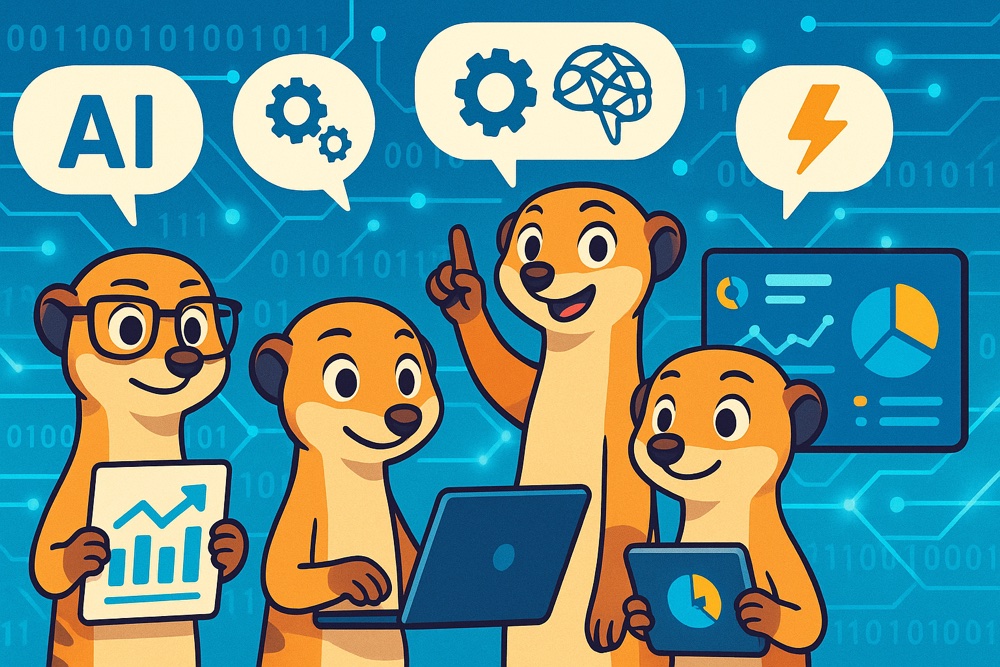
AI Agents in E-Commerce
According to the State of the Agentic AI Market Report 2025, more than 70% of surveyed AI experts expect agent technology to become a standard part of business operations by the end of 2025.
For Amazon sellers, vendors, and agencies, this opens up significant potential – from content creation to PPC optimization to product research. In this article, you’ll learn how AI agents work and how you can use them practically in e-commerce. Additional links to free guides and courses offer you the opportunity to deepen your knowledge of the topic.
What is an AI Agent?
The field of agentic AI is still in an early development phase. Many terms are used imprecisely. Not every system that generates content using large language models (LLMs) is automatically an AI agent.
For a solution to be considered an agent, it should meet at least two of the following three criteria:
-
Autonomy & Planning: An agent is not a mere command receiver. It analyzes a goal, breaks it down into subtasks, and creates an action plan. It independently decides on the sequence of steps and selects the appropriate tools for each task. The agent evaluates the results of its actions, recognizes errors or inefficient paths, and dynamically adjusts its strategy. This enables it to respond to unforeseen problems and improve its performance over time.
-
Tool Integration: Through the integration of external tools (APIs, databases, web services), an agent can not only retrieve information but also perform concrete actions – such as sending an email, entering data into a CRM system, or making a booking.
-
Access to Specialized Knowledge: An agent often has a “memory” and can access information that is typically not part of the training data or system prompt. This can include company internals or many non-public “manuals.” The agent can search through these to adapt its actions based on this knowledge.
These criteria allow agents to be distinguished from pure chatbots, which provide their answers exclusively based on trained knowledge.
However, a clear distinction between agents and tools like ChatGPT is becoming increasingly difficult, as ChatGPT also has access to various tools such as web search, code execution, and to some extent also memory.
How does an AI Agent work?
AI agents combine multiple components into an actionable system. At the center is usually a large language model (LLM) – such as GPT-5, Claude Sonnet, or an open-source model. This LLM takes on the role of the “thinker”: It analyzes the goals, plans the necessary steps, and makes decisions.
The control is carried out through an agent loop: A recurring cycle of thinking, acting, and evaluating. In each repetition of this cycle, the agent decides which tool or information is needed next to get closer to the goal.
The following graphic illustrates the four central elements that drive the system:
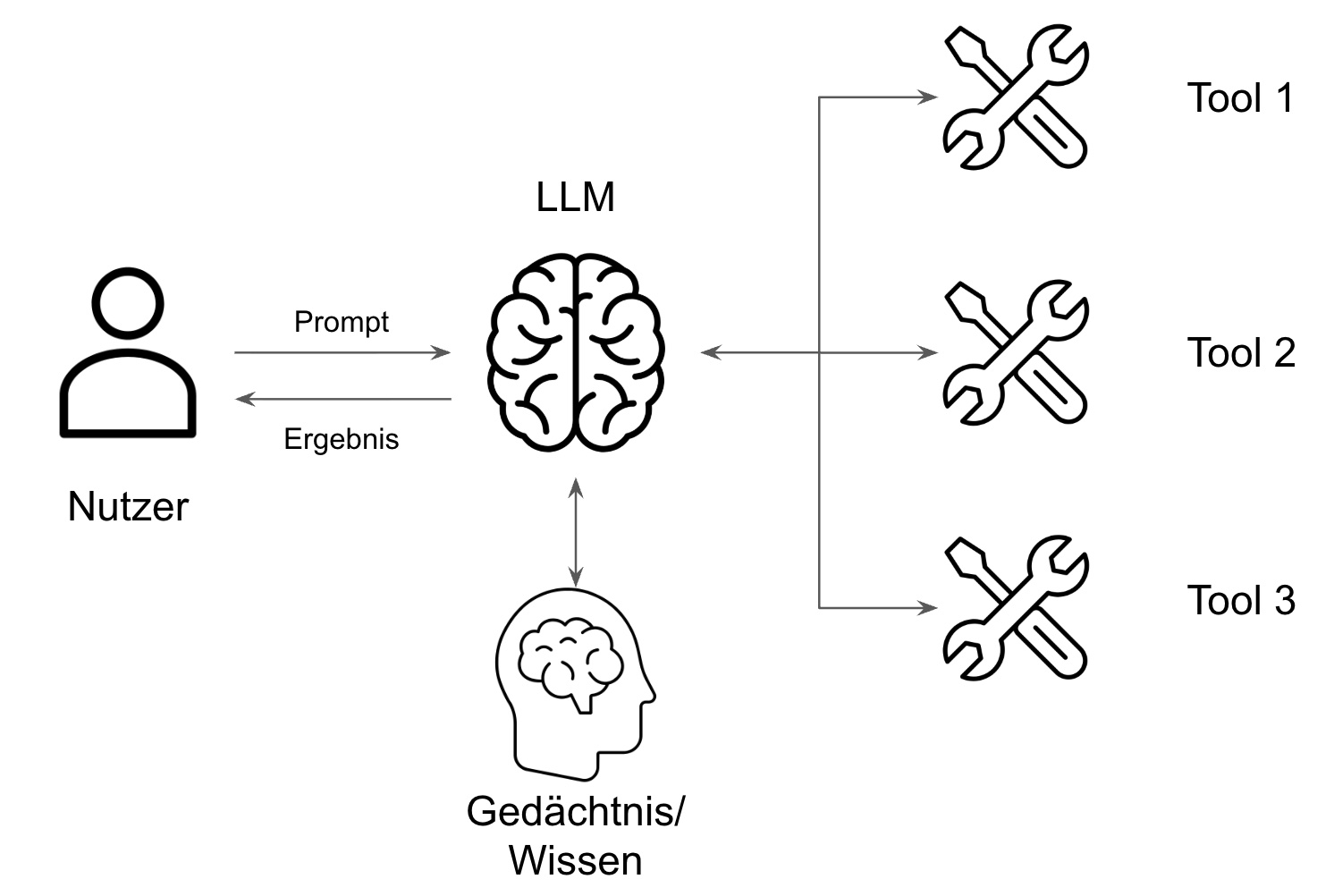
-
The User: They provide the overarching goal in the form of a prompt and receive the processed result at the end.
-
The Language Model: The central brain of the agent. It receives the prompt, breaks down the goal into subtasks, and creates an action plan. It is the controlling instance that decides when which tool or information is needed.
-
Memory/Knowledge: Here the agent has access to important information that lies outside the training data of the language model, such as company-specific knowledge.
-
Tools: These are the “arms and eyes” of the agent. Each tool has a specific capability, e.g., searching the internet, accessing a database, executing code, or triggering an action via an API (programming interface). The LLM can call these tools specifically.
Multiple AI agents can also be assembled into a “team” that interacts with each other. However, previous experience (as of October 2025) shows: The more complex these teams are built, the more unreliable/unpredictable the result becomes. As of today, complexity should still be reduced.
Practical Example: An AI Agent in Action
Let’s imagine a customer contacts an e-commerce chatbot of their online shop with the following request: “I would like to cancel my last order”
To solve this task, the agent will access a series of specialized tools that are shown as “Tool 1, 2, …” in the graphic above:
- Tool 1: Orders API: Can retrieve a customer’s order and cancel orders.
- Tool 2: Email API: Can send automatic confirmation emails to customers.
The agent loop now starts:
-
Step 1 (Thinking & Planning): The LLM analyzes the request and draws on its internal knowledge. It recognizes that orders can be canceled free of charge within 24 hours. The plan is created as follows:
- Search for last order (Tool 1).
- Check conditions / internal knowledge whether cancellation is possible free of charge (within 24h).
- If possible, cancel order (Tool 1).
- Send confirmation email to customer (Tool 2).
- Inform customer about successful cancellation.
-
Step 2 (Acting & Checking): The agent accesses Tool 1 (Orders API) to retrieve the details of the last order. The tool reports back: “Order from 09.11. at 14
, Status: ‘In Processing’, not yet shipped.” This information is stored in the current conversation context. -
Step 3 (Applying Knowledge & Deciding): The LLM applies its internal knowledge: “The order is less than 24 hours old and not yet shipped. A free cancellation is possible.” It decides to proceed with the cancellation.
-
Step 4 (Acting & Evaluating): The LLM calls Tool 1 (Orders API) and cancels the order. The tool confirms: “Order #12345 successfully canceled. Refund will be processed within 3-5 business days.”
-
Step 5 (Acting & Evaluating): Next, Tool 2 (Email API) is called to send an automatic confirmation email to the customer. The tool confirms: “Cancellation confirmation sent to customer@email.com.”
-
Step 6 (Final Result): The agent reports to the customer: “Your order #12345 has been successfully canceled. You will receive a confirmation email and the refund will be credited to your original payment method within 3-5 business days.”
How do agents interact with the “outside world”?
The true strength of AI agents lies not only in their ability to think and plan, but above all in the fact that they can actively interact with the digital world. While a simple chatbot only responds based on its training data, agents can access current information, perform actions, and process results in real time. This interaction with the “outside world” takes place through various channels, each with their own advantages and disadvantages.
Browser
When there are no interfaces (see next paragraph), AI agents use browser automation to interact with websites. This method allows agents to behave like human users and browse websites, fill out forms, or extract data.
Modern browser automation tools like Playwright or Selenium enable agents to control real browser instances. The agent can execute JavaScript, click on elements, enter text, and create screenshots – just like a human user.
An Amazon seller agent could, for example, conduct competitor analyses using browser automation by automatically navigating through product pages, collecting reviews, and making price comparisons. The agent can execute complex search queries, apply filters, and capture data in a structured way without needing to develop a special API integration for each target page. This flexibility makes browser-based agents a powerful tool for automating web-based business processes.
Interfaces / APIs
Agents often use so-called APIs / interfaces that serve as bridges between the agent and external systems. These interfaces enable the agent to retrieve data, trigger actions, and communicate with various platforms.
In the e-commerce context, agents access product databases, for example, to query current availability and prices, or they use payment APIs to securely process transactions. An Amazon seller agent could access sales data via the Amazon Seller Central API, query inventory levels, or create new product listings.
The challenge lies in the variety of available interfaces. Each platform, tool, and service has its own API standards, authentication methods, and data formats. An agent that is supposed to work with different systems must therefore make individual adjustments for each interface. This fragmentation not only complicates development but also the maintenance and scaling of agent solutions.
Therefore, the developers at Anthropic came up with something to reduce this complexity. The Model Context Protocol (MCP).
Model Context Protocol
The Model Context Protocol (MCP) from Anthropic provides a solution for the complexity of different API standards. It defines a unified standard that enables AI models to communicate seamlessly with external tools and data sources without needing to develop an individual interface for each combination.
The core idea of MCP is creating a common “language” between AI systems and external tools. You can think of it as a kind of “USB-C for AI”: a unified connection that simply works, regardless of which model or tool is connected. An agent equipped with MCP can theoretically communicate with any compatible tool without needing to make specific adjustments.
For developers, this means a significant simplification: Instead of programming a separate interface for each new tool integration, it’s sufficient to implement the MCP protocol. This not only reduces development effort but also makes agent solutions more flexible and maintainable.
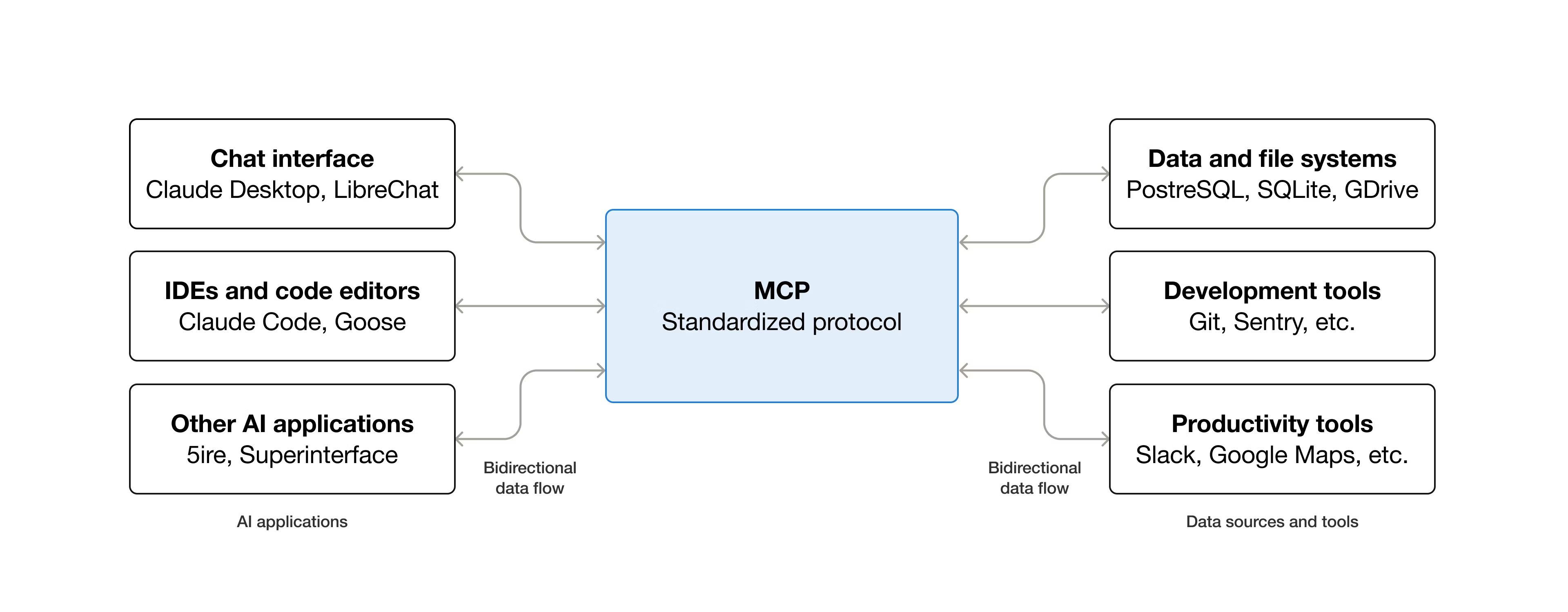
Agentic Commerce Protocol
While MCP sets a general standard for communication, specialized protocols are emerging for specific industries. A concrete example of this is the Agentic Commerce Protocol (ACP).
ACP is an open standard specifically designed to enable direct and secure communication between AI agents (like ChatGPT) and online retailers’ systems. The goal is to create a new sales channel that allows customers to discover, compare, and purchase products directly within an AI chat without having to visit a website. Through standardized transmission of product feeds and secure payment tokens, retailers can connect their systems to a variety of AI assistants.
Learn more about this topic in our article about Agentic Commerce.
How can AI agents be created?
No-Code Platforms
No-code platforms like n8n, Zapier, or make.com enable even non-technical users to develop their own agent solutions without needing to master programming languages. These platforms work on the principle of visual programming: Complex workflows are created by connecting pre-built building blocks, similar to a flowchart.
The functionality is based on so-called “nodes” or “Zapier steps,” each fulfilling a specific function. A node can, for example, receive an email, another can query a database, a third can request a language model, and a fourth can send a response. These nodes are placed via drag & drop on a visual interface and connected by lines that define the data flow and execution sequence.
To create a simple customer service agent, you would connect the following nodes, for example: “Receive email” → “Analyze text” → “Request language model” → “Generate response” → “Send email.” The platform handles the entire technical implementation while the user can focus on the logic and workflow. Additionally, these platforms offer pre-built integrations with hundreds of services, enabling even complex agents to be connected to external systems.
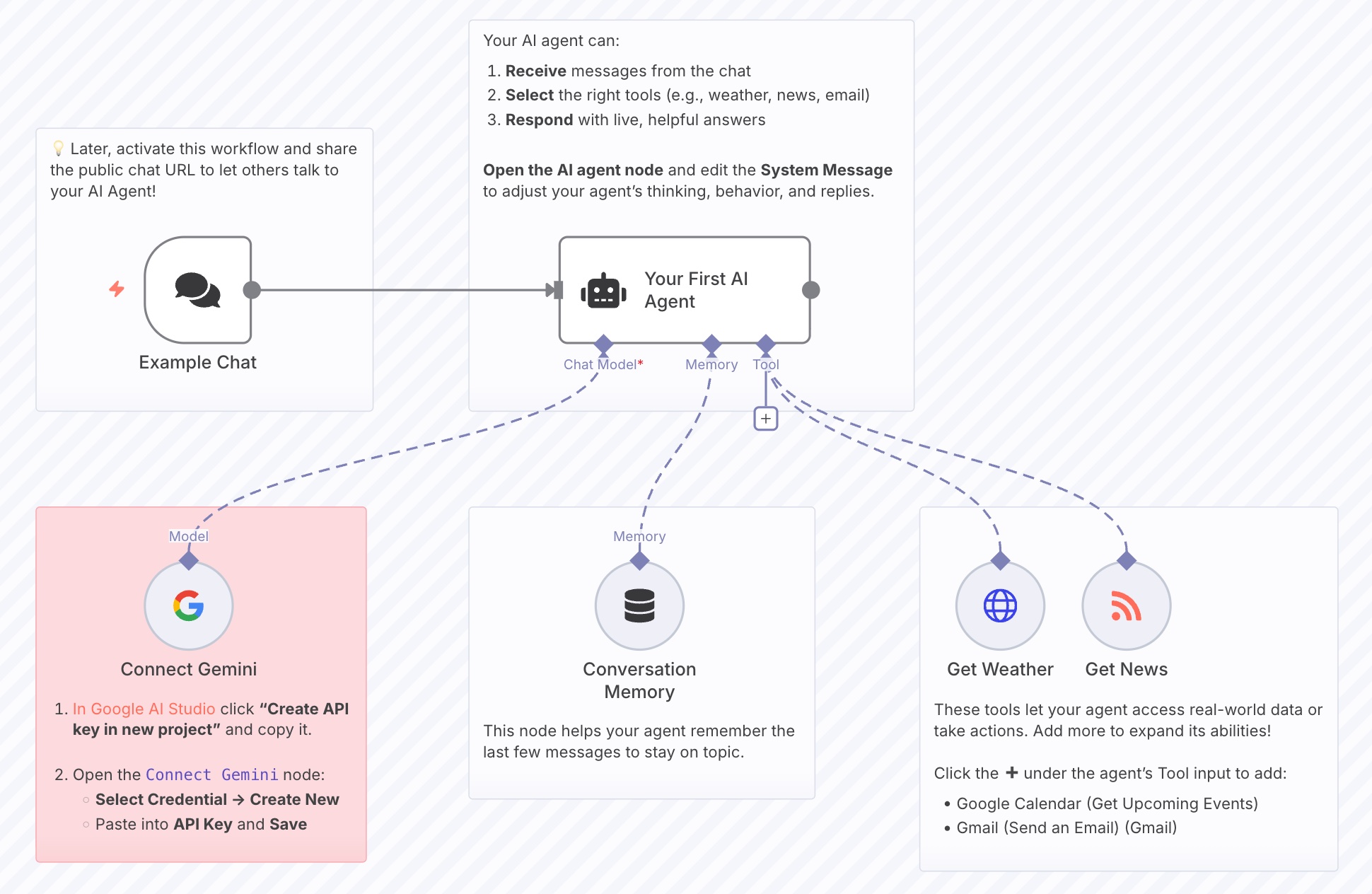
Coding Frameworks
Coding frameworks are specialized libraries and tools that help developers create AI agents programmatically. Unlike no-code platforms, they offer greater flexibility and control but require corresponding programming skills.
Despite their advantages, coding frameworks also bring some challenges. Many frameworks are strongly tied to specific LLM providers or cloud services, which can lead to vendor lock-in, where a change requires significant refactoring effort.
Among the better-known frameworks are:
- LangChain/LangGraph: Probably the best-known framework offers a comprehensive collection of tools and a graph-based architecture for complex agent workflows. Particularly strong in integrating various LLM providers and orchestrating multi-agent systems.
- LlamaIndex: Specialized in creating RAG systems (Retrieval-Augmented Generation) and processing large document volumes. Ideal for agents that need to work with extensive knowledge databases.
- CrewAI: Focused on multi-agent systems where different agents with specific roles work together. Offers sophisticated orchestration mechanisms for complex task distribution.
- AutoGen: Microsoft’s framework for conversational AI, which is particularly strong in creating chatbots and dialog systems.
The use of coding frameworks is particularly worthwhile for complex, individual requirements where flexibility and control outweigh other factors. For simple use cases, no-code solutions or direct API integrations can often be more efficient.
AI Agents at AMALYTIX
AMALYTIX has developed a specialized Finance AI Agent that helps Amazon sellers and vendors analyze complex financial data and recognize market-relevant changes. This agent accesses comprehensive financial evaluations of markets and products through integrated tools and can independently identify larger changes in sales data.
The Finance AI Agent analyzes the performance of various product categories, market segments, and individual items on request. It automatically recognizes significant deviations in sales and analyzes the underlying causes. For example, it can determine that a sudden drop in sales for a product is due to reduced visibility for selected keywords.
Operation is through an intuitive chat interface that is accessible to both sellers and vendors. Users can ask the agent direct questions like “What market changes have occurred in the last 30 days?” The agent then analyzes the relevant financial data, creates detailed evaluations, and delivers concrete action recommendations based on the recognized patterns and trends.
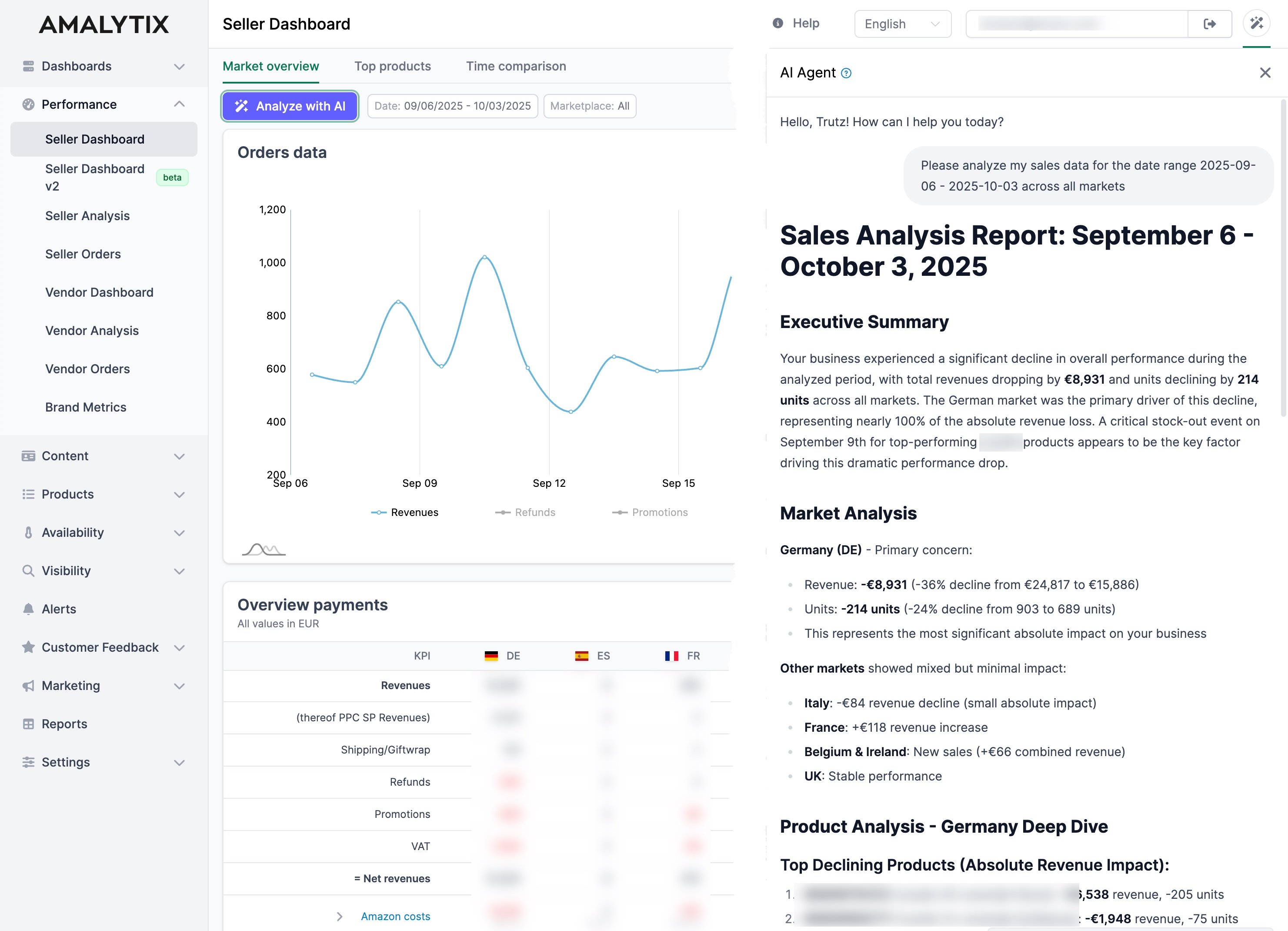
Further Resources
The following selection of free guides and courses offers you the opportunity to deepen your knowledge about AI agents in a targeted way.
Free AI Agent Guides
- OpenAI: A practical Guide to Building Agents - Fundamentals for agent development with orchestration patterns
- Anthropic: Building Effective Agents - Technical guide for agent-based systems with modern LLMs
- Google: Agents - Introduction to agent-based AI systems with technical fundamentals
Free AI Agent Courses
- Hugging Face: AI Agents Course - Interactive course for Python developers with frameworks like LangGraph and LlamaIndex
- Deeplearning: Various Courses - Various offerings on the topic of “Agents”
- Coursera: Specialization for AI Agent Developer - Comprehensive course series for design and development of software agents
AMALYTIX AI Workshop
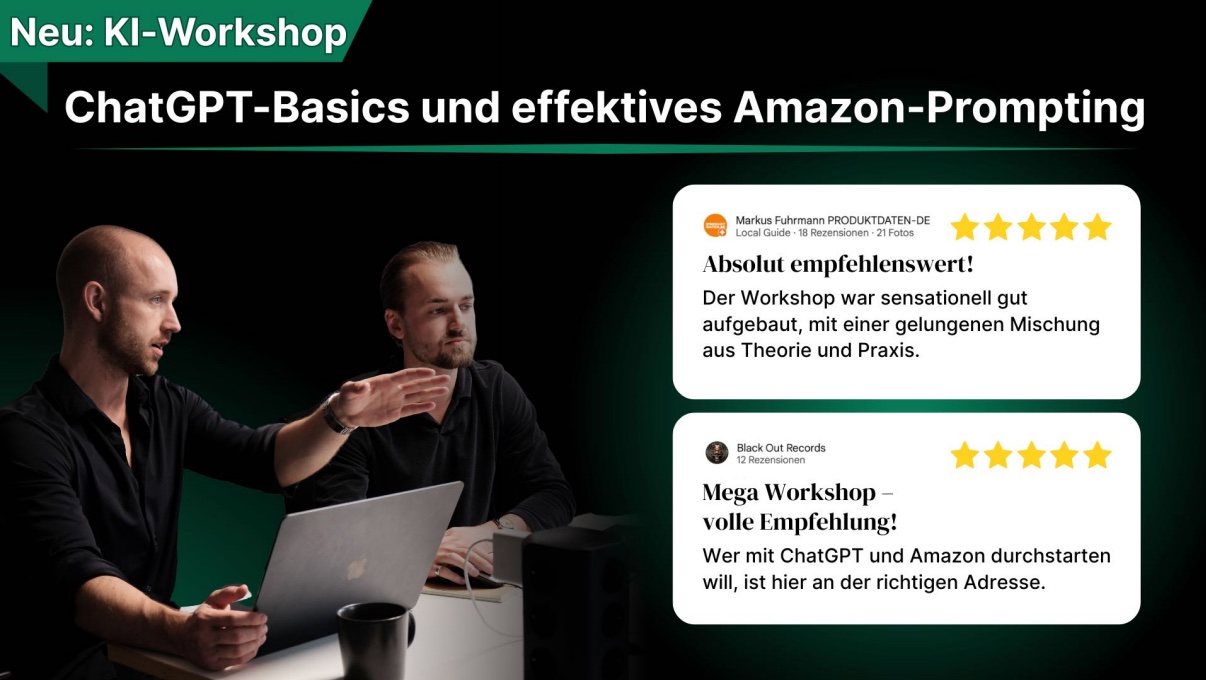
The AMALYTIX AI Workshop teaches how Amazon sellers, vendors, and agencies can use generative AI in everyday life – from listing optimization and customer feedback analysis to image creation and data analysis. The workshop is aimed at teams seeking directly applicable knowledge to make AI technologies useful for their Amazon processes.
The format is flexible – either remote or on-site in the DACH region – and lasts one to two days. Work is done with your own product data, so all content is directly applicable. The focus is on the fundamentals of modern AI models (e.g., ChatGPT, Gemini), effective prompting, and specific Amazon use cases.
Interested? Here’s the link to the free initial consultation.
FAQ
How does an AI agent work?
An AI agent combines multiple software components into an actionable system. At the center is a large language model (LLM) that acts as the “thinker”: It analyzes the goal and makes decisions. The process is controlled through an “agent loop,” a recurring cycle of thinking, acting, and evaluating. In each repetition of this cycle, the agent decides which tool (e.g., an API or browser) it will use next to gradually get closer to the overarching goal.
Are AI agents the same as chatbots?
No. A simple chatbot only responds to direct inputs. An AI agent, on the other hand, proactively pursues a goal. It plans independently, uses various tools, and performs actions instead of just responding.
What is a multi-agent system?
In this case, multiple specialized AI agents work together as a coordinated team. They exchange information and take on different roles to solve complex tasks more efficiently than a single agent.
Are AI agents reliable?
The technology is new. For clearly defined, repetitive tasks (e.g., data research and processing), reliability is already high. However, errors can occur with complex, open-ended goals, which is why human supervision remains essential in any case.
Subscribe to Newsletter
Get the latest Amazon tips and updates delivered to your inbox.
Wir respektieren Ihre Privatsphäre. Jederzeit abbestellbar.
Related Articles
Agentic Commerce Protocol (ACP): How AI Is Transforming Online Retail
With the Agentic Commerce Protocol (ACP), a new era in e-commerce begins: AI assistants like ChatGPT take over the shopping process. What does this mean for brands and online shops?

Trutz Fries
Amazon Product Types & Keywords: Why AI Categorization Fails
Discover why Amazon's AI misclassifies products 20% of the time and how proper categorization and keyword optimization boost visibility and sales.

Christoph Vogt
Amazon Rufus Study: 1,300+ Products Reveal AI Patterns
Statistical analysis of 1,300+ Amazon Rufus recommendations reveals key patterns: 92% Prime eligible, 4.5+ ratings, and optimal listing attributes.

Trutz Fries


